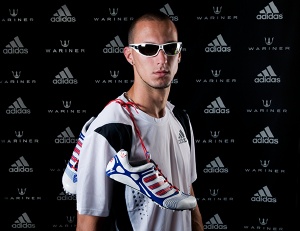Aug 17 2008
Designed to optimize world champion and Olympic hopeful Jeremy Wariner's strengths in the 400m race, adidas' revolutionary new Lone Star spike hits the track at the U.S. Olympic Trials in Eugene, Ore., this weekend. Wariner will compete in the new shoe, wearing different color styles throughout the competition and at the Beijing 2008 Olympic Games in August.

adidas worked with Wariner for more than two years to create the revolutionary adidas Lone Star spike, which is named after Wariner’s home state of Texas. In addition to Jeremy’s new logo, the adidas Innovation Team introduces multiple pioneering technologies in this spike, making this the most technologically advanced and one of the lightest spikes to-date. The Lone Star is the world’s first asymmetrical 400m spike, featuring the first ever full-length carbon nanotubes reinforced plate and the exclusive adidas progressive-compression spike.
“We spent more than two years working with Jeremy Wariner, the best curve runner in the world to design the adidas Lone Star,” said Mic Lussier, adidas Innovation Team Leader, adidas America. “We know long-sprint races are won and lost in the curves so we looked at what he already does best and from there created the finest curve running shoes in the world. The adidas Lone Star allows Jeremy to push even better in the turn and provides him with even more physical confidence, stability and efficiency.”
World’s First Asymmetrical 400m Spikes
After studying Wariner’s running pattern in the adidas labs through high-speed video and pressure mapping, adidas worked with him to create something entirely new in long-sprint running. The adidas team of advanced engineers, designers and biomechanists were able to see how differently Wariner uses each foot as he runs.
As a result of these differences, they developed the first-ever asymmetrical spikes to cater to the specific needs and the role of each foot, and to build on the fact that long-sprint races are won in the curves. Similar to a race car having different suspension on the left and right sides to race in the curves, adidas created different shoes to build on the fact that Wariner uses his left foot for stabilization and his right foot for propulsion.
First Ever Carbon Nanotubes Full-Length Plate
Leveraging new innovations from the plastics industry, adidas applied materials only previously used in the automotive and aerospace industries to design a carbon nanotubes reinforced full-length plate (nanoplate). This thinner and stronger one piece, full-length plate provides Wariner more stability, comfort, better torsion, safety and increased flexibility while minimizing the energy loss.
Mechanical and chemical bonds with the microscopically tiny nanotubes increase the structural integrity and durability of the plate, allowing adidas to build one continual flexible piece as opposed to the previous three-piece design, which included metal screw-in spikes and multiple fold points adhered together by cement. The new full-length plate measures about 1/3 the thickness of Jeremy’s previous spike and weighs 50 percent less, making it the lightest spike ever created by adidas.
With less material between his foot and the track, the new plate allows Jeremy’s feet to be closer to the ground, therefore promoting more natural movement of the foot. The material’s defining physical properties result in increased flexibility, torsion and less energy loss as Jeremy’s foot comes off the track.
New adidas Progressive-Compression Spike
Acting like a piston on the track, the progressive-compression spike design innovation is exclusive to adidas. Traditional spikes cut into the track material causing athletes to exert unnecessary energy with each stride as they pull the spike back out of the track. The revolutionary spike on Jeremy’s shoe allows him to compress the track, thus riding its surface like a piston instead of digging in and out of it with each stride and wasting valuable energy. The tapered grooves of the progressive-compression spike provide the best penetration/compression ratio, thus optimizing the spring-like elastic property of the track surface.
Split Upper with POWERWEB Bands
The split upper in the forefoot allowed adidas to better tailor the shoe to hold Jeremy’s foot, creating a glove-like fit. The POWERWEB bands on the back of the shoe are similar to the look and functionality of adidas TECHFIT™POWERWEB apparel Jeremy races in. POWERWEB bands mimic the skeletal-muscles complex and are placed on the shoe to wrap and hold his heel and midfoot for increased support and stability.
Jeremy’s traditional “Pookie” nickname is replaced on the adidas Lone Star with a new logo of the letter W stylized as a crown and illustrating Jeremy as the undefeated champion. The name of the shoe, Lone Star, comes to life with an outline of the state of Texas on the tongue.
In addition to Jeremy’s spike technology, Allyson Felix and Tyson Gay will also wear custom adidas track spikes in Eugene and leading up to competition in Beijing. Both Felix’s “Shug,” spike and Gay’s “Trinity” spike feature specific performance innovations that cater to their race specialty and running style. Their spikes were a design collaboration between adidas and the athletes to represent their personalities with colors, style and logos. Tyson’s vintage design was inspired by the spikes made by Adi Dassler for Jesse Owens to wear in the 1936 Berlin Olympics. adiZero and Bounce running shoe versions of the athlete inspired custom spikes will be available in retail starting January 2009.